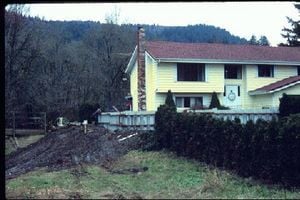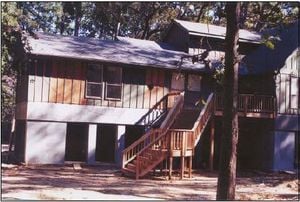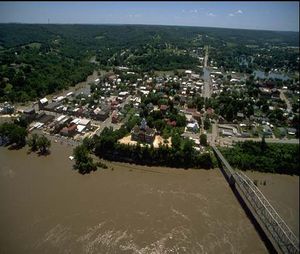
Regardless of the risks involved, people do and will continue to live in the floodplain, both upstream and downstream from dams. And, as scientists and river managers have discovered, many of the dams constructed for flood management are no longer or have never fully achieved that objective. Floodplain management encompasses a wide variety of regulatory, planning and structural measures aimed at reducing the risk of loss of property and human lives in the event of a flood. Flood management measures include zoning, flood proofing, building standards, and warning systems. An important component of floodplain management is controlling the development of floodplains to place people and flood intolerant land uses in areas with relatively lower flood risk (i.e., land at higher elevation or greater distance from the river). Land with greater flood risk is used for more flood tolerant activities, such as agriculture, parks and parking lots. This type of zoning or resettlement has the biggest impact on the need for an existing or new dam aimed at flood management. If property and people cannot be located out of flood prone areas, flood proofing or some of the "natural" flood management measures discussed above can prevent floodwaters from reaching areas at risk. While it is not likely that flood proofing alone will lead to the removal of a dam designed for flood management or delay a proposed flood management dam, it can be a useful tool when used in conjunction with the alternatives discussed above.
Flood proofing[edit | edit source]
Structures may be modified in a variety of ways to reduce the risk of floodwater penetration and damage, including: waterproofing walls, fitting openings with permanent or temporary doors, gates or other closure devices, fitting one-way valves on sewer lines and building boundary walls around the house structure. The internal design of buildings may also be altered to reduce flood damage. For example, electrical circuits and sockets may be permanently routed and located at high rather than low levels. In extreme cases, buildings may be raised on piers and occasionally buildings will be built on raised mounds or with important areas above likely flood levels. Further measures may include sump pumps that begin operating in basements when water levels rise, and contingency plans for when a flood is anticipated.
Advantages[edit | edit source]
The benefit of flood proofing is that it allows existing or new structures to be located within an area prone to flooding if the structure cannot be moved or located in a flood-free area. Flood proofing could also allow areas that are now prevented from receiving floodwaters to flood in the future, providing all the benefits of re-flooding areas described above. Also, depending on the area, these practices can replace a dam, levee, or other traditional flood management structure.
Disadvantages[edit | edit source]
Retrofitting homes and other structures to protect them from flood damage can be expensive and disruptive to families or businesses. In addition, although a structure might be protected from flood damage, a degree of risk and inconvenience remains for the people or operations occupying the structures sitting in floodwaters.

Costs[edit | edit source]
Costs for flood proofing vary depending on the combination or complexity of tactics pursued.
- Lifting a house to install a taller foundation or piers could cost as little as $30,000 or more than $200,000.[1]
- Preventive measures for sewer pipes and the flooding of basements or first floors include installation of back-up valves or gates, standpipes, sewage ejector pumps, and overhead sewers and can range anywhere from $100 to $6,000.[2]
- The average price range for materials, labor, and installation of a Floodguard flood wall is $100 to $140 per lineal foot.[3] A flood wall can also be incorporated into the actual wall of the house by retrofitting the structure with a waterproof veneer (appropriate in areas where flood depth is generally two feet or less). The average cost for retrofitting a house or building with waterproof veneer is $10 per square foot of exterior wall.[4]
Flood proofing case study[edit | edit source]
Mandeville, Louisiana, has a number of old homes and businesses of historical value on the shore of Lake Pontchartrain in Louisiana. Southerly winds and tidal influence back up water into these developed areas, with occasional strong winds and heavy rainfall responsible for the majority of flooding. For many citizens relocating out of the floodplain or elevating their homes is not an option, and flood proofing has been used to prevent excessive flood damage. To flood-proof their homes and businesses, Mandeville citizens sealed all openings below flood level on building exteriors and covered walls, doors, windows, vents and other building openings with waterproofing compounds and impermeable sheeting. Due to the pressure from the water on the structure, flood proofing only protects buildings when flood depths are no more than three feet. Two historic area restaurants, Bechac's and RIP's, had experienced flooding problems in the past and faced restrictions on what could be done to the structure by the State Historic Preservation Office. Bechac's, valued at $1.5 million, had a total of $35,175 in flood damage from four past floods, and RIP's, valued at $700,000, had $94,055 in flood damage from eleven past flood events. Final costs of dry flood proofing came to $190,000 for Bechac's restaurant and $200,000 for RIP's restaurant. Since then, both businesses have avoided damages during at least two floods.[5]
To read the complete Mandeville case study, visit http://www.fema.gov/pdf/fima/performance.pdf.
Where you can go for help[edit | edit source]
- Protecting Your Home From Future Flood Damage: http://www.fema.gov/nwz97/prothom.shtm.
- Above the Flood: Elevating Your Floodprone House: http://www.fema.gov/hazards/floods/fema347.shtm.
- Homeowner's Guide to Retrofitting: Six Ways to Protect Your House from Flooding: http://www.fema.gov/hazards/hurricanes/rfit.shtm.
- Federal Emergency Management Agency and the Federal Insurance Administration. Guide to Non-Residential Floodproofing—Requirements and Certification for Buildings Located in Special Flood Hazard Areas: Guide to Non-Residential Floodproofing.

Resettlement[edit | edit source]
In many cases, because floodplains are largely developed, separating people and property from flood risk requires resettlement. The relocation of property either from high-risk to low-risk floodplain land, or from floodplain to flood-free land, is a strategy that is used when frequent and severe flooding occurs. Given that the threat to life and/or property is the driving reason many dams are built for flood management, eliminating both of these from the floodplain has the largest impact on the need for new or existing dams.
Advantages[edit | edit source]
The main benefit of resettlement is that the resettled people and property are removed from flood prone areas permanently, eliminating the risk of flood damage. Once a community is resettled, the dam or other flood management structure could be removed or avoided and the river reconnected to its natural floodplain.
Disadvantages[edit | edit source]
The drawbacks to resettlement include the great cost and inconvenience of moving families and businesses. In addition, adequate and affordable high ground might not be available in an area acceptable to the community to be resettled.
Costs[edit | edit source]
Resettlement is an expensive proposition in the short term, but often is less expensive when the costs of future floods avoided are considered. For example, in Arnold, Missouri, the total amount of federal disaster assistance granted after the 1993 floods was close to $1.5 million dollars. After the floods of 1995, the fourth largest flood in Arnold's history, the damage was less than $72,000 as a result of non-structural mitigation— the acquisition of flood-prone or flooddamaged properties and relocation of structures.[6]
Resettlement Case Study[edit | edit source]
The Great Midwest Flood of 1993 resulted in $15 billion in damages, including the displacement of tens of thousands of families, loss of life and demonstrating the failure of traditional flood management measures, such as levees.[7] Rather than face the threat of continued flooding, some citizens chose to resettle on higher ground. Approximately 20,000 Midwesterners decided to move out of the floodplain, resulting in the relocation of more than 8,000 homes and business. This is the largest voluntary relocation after a flood in U.S. history. Furthermore, farmers voluntarily converted more than 50,000 acres of flooded farmland to wetlands.[8] Relocation efforts in a town near St. Louis led to a 99 percent drop in federal disaster relief costs, dropping from $26.1 million in 1993 to less than $300,000 in 1995. This is in stark contrast to another town near St. Louis that chose a more structural flood management approach, enlarging its levees in order to permit development of the floodplain. Despite the upgrades, this town suffered more than $200 million in damages, one of the highest bills for flood-related damage, as a result of the 1993 floods.[9]
To read more about the Great Midwest case study, visit http://www.greenscissors.org/water/floodcontrol.htm.
Where you can go for help[edit | edit source]
- Federal Emergency Management Agency, Hazard Mitigation Grant Program: http://www.fema.gov/fima/hmgp/.
- American Rivers, Programs to Help You Restore Your Floodplain: http://web.archive.org/web/20031203154848/http://www.amrivers.org:80/floodplainstoolkit/programs.htm.
- The Trust for Public Land, Flood Control/Hazard Mitigation: http://web.archive.org/web/20090309095740/http://www.tpl.org:80/tier3_cdl.cfm?content_item_id=1102&folder_id=72.
See also[edit | edit source]
References[edit | edit source]
- ↑ Mack Construction, Homepage, http://www.stevemack.com/lifting.html (19 March 2003).
- ↑ City of Hammond, Indiana Sewer Department, A Property Owner's Guide to Flood Proofing, http://hmdin.com/sewer/FloodProofingGuide.htm (16 March 2004).
- ↑ Chehalis River Council, Personal Flood Wall Facts, http://web.archive.org/web/20090309053115/http://www.crcwater.org:80/issues/fludwall.html> (16 March 2004).
- ↑ City of Wood River, Illinois, Protecting Your Property from Flooding: Exterior Walls, http://web.archive.org/web/20150629152535/http://www.woodriver.org:80/FloodInfo/ProtectProperty/ExteriorWalls.htm (16 March 2004).
- ↑ Association of State Floodplain Managers and Federal Emergency Management Agency, "Louisiana: City of Mandeville, Louisiana," Mitigation Success Stories, 4th ed., January 2002, http://www.http://www.floods.org/MSS_IV.pdf (11 June 2002).
- ↑ Federal Emergency Management Agency, Success Stories from the Missouri Buyout Program, 2002, http://www.fema.gov/mit/cb_aqres.htm (19 February 2002).
- ↑ Larson, L.W., "The Great USA Flood of 1993," Presented at the International Association of Hydrological Sciences Conference, Anaheim, CA, June 1996, http://www.nwrfc.noaa.gov/floods/papers/oh_2/great.htm (5 July 2002).
- ↑ "Wetland Destruction Leads to Devastating Floods," Affinity, 15 April 1997, http://web.archive.org/web/20020421194436/http://www.greenlink.org:80/affinity/41597/flooding.html (11 June 2002).
- ↑ Taxpayers for Common Sense, "Rotten to the Corps: Army Corps of Engineers Flood Control Construction $1.25 billion," Greenscissors: Cutting Wasteful and Environmentally Harmful Spending, 2002, http://www.greenscissors.org/water/floodcontrol.htm> (11 June 2002).